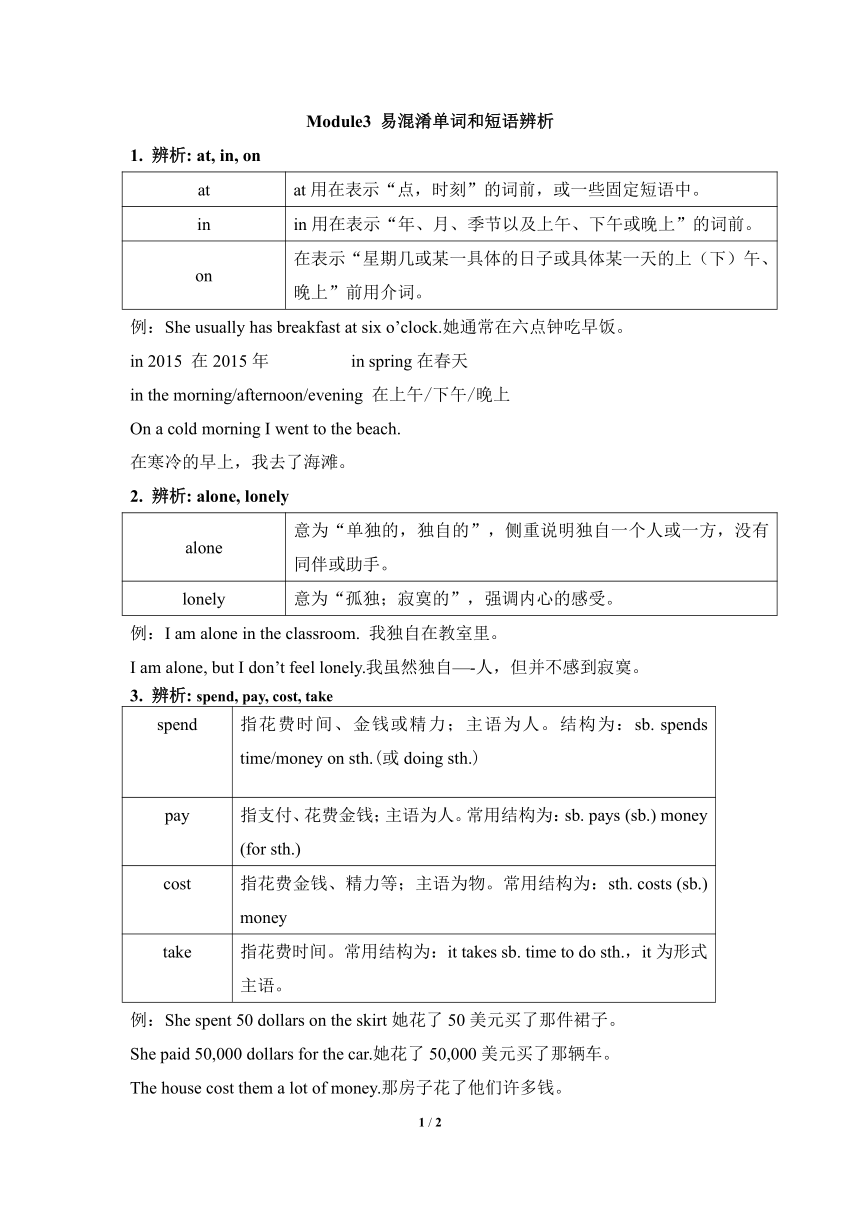外研版七年级英语下册 Module3 易混淆单词和短语辨析
文档属性
| 名称 | 外研版七年级英语下册 Module3 易混淆单词和短语辨析 |  | |
| 格式 | doc | ||
| 文件大小 | 42.0KB | ||
| 资源类型 | 教案 | ||
| 版本资源 | 外研版 | ||
| 科目 | 英语 | ||
| 更新时间 | 2022-06-11 21:04:11 | ||
图片预览

文档简介
Module3 易混淆单词和短语辨析
1. 辨析: at, in, on
at at用在表示“点,时刻”的词前,或一些固定短语中。
in in用在表示“年、月、季节以及上午、下午或晚上”的词前。
on 在表示“星期几或某一具体的日子或具体某一天的上(下)午、晚上”前用介词。
例:She usually has breakfast at six o’clock.她通常在六点钟吃早饭。
in 2015 在2015年 in spring在春天
in the morning/afternoon/evening 在上午/下午/晚上
On a cold morning I went to the beach.
在寒冷的早上,我去了海滩。
2. 辨析: alone, lonely
alone 意为“单独的,独自的”,侧重说明独自一个人或一方,没有同伴或助手。
lonely 意为“孤独;寂寞的”,强调内心的感受。
例:I am alone in the classroom. 我独自在教室里。
I am alone, but I don’t feel lonely.我虽然独自—-人,但并不感到寂寞。
3. 辨析: spend, pay, cost, take
spend 指花费时间、金钱或精力;主语为人。结构为:sb. spends time/money on sth.(或doing sth.)
pay 指支付、花费金钱;主语为人。常用结构为:sb. pays (sb.) money (for sth.)
cost 指花费金钱、精力等;主语为物。常用结构为:sth. costs (sb.) money
take 指花费时间。常用结构为:it takes sb. time to do sth.,it为形式主语。
例:She spent 50 dollars on the skirt她花了50美元买了那件裙子。
She paid 50,000 dollars for the car.她花了50,000美元买了那辆车。
The house cost them a lot of money.那房子花了他们许多钱。
It took him three weeks to finish the work.完成这项工作花了他三个月时间。
4. 辨析: dress, put on, wear
dress 意为“给……穿衣”,后接人,不跟衣服。
put on 意为“穿上,戴上”,强调动作,为动副结构的短语,接代词放在on之前,接名词放在on之前或之后。
wear 意为“穿着,戴着”,后面既可以接衣服、物,又可以接表示颜色的词,强调状态。
例:The boy is old enough to dress oneself.这个男孩足够大了,他能够自己穿衣服。
Your coat is on the bed. Please put it on.你的衣服在床上。请把它穿上吧。
She always wears a red hat.她总是戴着一顶红色的帽子。
5. 辨析: go to bed, sleep
go to bed 意为“上床睡觉”强调从脱去衣服到上床这一动作,表示准备睡觉,不含“睡着”之意。
sleep 指睡着的过程,其用于现在进行时中,表示“正在睡觉”。
例:We usually get up at six in the morning and go to bed at nine in the evening.
我们通常早晨六点起床,晚上九点上床睡觉。
Please be quiet. My father is sleeping.请安静。我爸爸正在睡觉。
6. 辨析: win, beat
win 意为“获胜”,通常用game, war, match, prize之类的名词作宾语,不可以接表示人的词作宾语。其过去式、过去分词为won,现在分词为winning。
beat 意为“赢”,但beat实际上表示“击败,胜过”,其后接的宾语多是表示与之比赛、战斗的人或代表体的名词、代词。此外,beat还表示“敲打,(心脏等)跳动”。其过去式为beat,过去分词为beaten,现在分词为beating。
例:Which team won the football match 哪个队赢了那场足球赛?
Our class beat theirs in the basketball match.在这场篮球赛中我们班战胜了他们班。
2 / 2
1. 辨析: at, in, on
at at用在表示“点,时刻”的词前,或一些固定短语中。
in in用在表示“年、月、季节以及上午、下午或晚上”的词前。
on 在表示“星期几或某一具体的日子或具体某一天的上(下)午、晚上”前用介词。
例:She usually has breakfast at six o’clock.她通常在六点钟吃早饭。
in 2015 在2015年 in spring在春天
in the morning/afternoon/evening 在上午/下午/晚上
On a cold morning I went to the beach.
在寒冷的早上,我去了海滩。
2. 辨析: alone, lonely
alone 意为“单独的,独自的”,侧重说明独自一个人或一方,没有同伴或助手。
lonely 意为“孤独;寂寞的”,强调内心的感受。
例:I am alone in the classroom. 我独自在教室里。
I am alone, but I don’t feel lonely.我虽然独自—-人,但并不感到寂寞。
3. 辨析: spend, pay, cost, take
spend 指花费时间、金钱或精力;主语为人。结构为:sb. spends time/money on sth.(或doing sth.)
pay 指支付、花费金钱;主语为人。常用结构为:sb. pays (sb.) money (for sth.)
cost 指花费金钱、精力等;主语为物。常用结构为:sth. costs (sb.) money
take 指花费时间。常用结构为:it takes sb. time to do sth.,it为形式主语。
例:She spent 50 dollars on the skirt她花了50美元买了那件裙子。
She paid 50,000 dollars for the car.她花了50,000美元买了那辆车。
The house cost them a lot of money.那房子花了他们许多钱。
It took him three weeks to finish the work.完成这项工作花了他三个月时间。
4. 辨析: dress, put on, wear
dress 意为“给……穿衣”,后接人,不跟衣服。
put on 意为“穿上,戴上”,强调动作,为动副结构的短语,接代词放在on之前,接名词放在on之前或之后。
wear 意为“穿着,戴着”,后面既可以接衣服、物,又可以接表示颜色的词,强调状态。
例:The boy is old enough to dress oneself.这个男孩足够大了,他能够自己穿衣服。
Your coat is on the bed. Please put it on.你的衣服在床上。请把它穿上吧。
She always wears a red hat.她总是戴着一顶红色的帽子。
5. 辨析: go to bed, sleep
go to bed 意为“上床睡觉”强调从脱去衣服到上床这一动作,表示准备睡觉,不含“睡着”之意。
sleep 指睡着的过程,其用于现在进行时中,表示“正在睡觉”。
例:We usually get up at six in the morning and go to bed at nine in the evening.
我们通常早晨六点起床,晚上九点上床睡觉。
Please be quiet. My father is sleeping.请安静。我爸爸正在睡觉。
6. 辨析: win, beat
win 意为“获胜”,通常用game, war, match, prize之类的名词作宾语,不可以接表示人的词作宾语。其过去式、过去分词为won,现在分词为winning。
beat 意为“赢”,但beat实际上表示“击败,胜过”,其后接的宾语多是表示与之比赛、战斗的人或代表体的名词、代词。此外,beat还表示“敲打,(心脏等)跳动”。其过去式为beat,过去分词为beaten,现在分词为beating。
例:Which team won the football match 哪个队赢了那场足球赛?
Our class beat theirs in the basketball match.在这场篮球赛中我们班战胜了他们班。
2 / 2
同课章节目录
- Module 1 Lost and found
- Unit 1 Whose bag is this?
- Unit 2 Are they yours?
- Unit 3 Language in use
- Module 2 What can you do ?
- Unit 1 I can play the piano
- Unit 2 I can run really fast
- Unit 3 Language in use
- Module 3 Making plans
- Unit 1 What are you going to do at the weekends?
- Unit 2 We're going to cheer the players.
- Unit 3 Language in use
- Module 4 Life in the future
- Unit 1 Everyone will study at home
- Unit 2 Every family will have a small plane.
- Unit 3 Language in use
- Module 5 Shopping
- Unit 1 What can I do for you?
- Unit 2 You can buy everything on the Internet
- Unit 3 Language in use
- Module 6 Around town
- Unit 1 Could you tell me how to get to the Nationa
- Unit 2 The London Eye is on your right.
- Unit 3 Language in use
- Revision module A
- Module 7 My past life
- Unit 1 I was born in a small village.
- Unit 2 I was born in Quincy.
- Unit 3 Language in use
- Module 8 Story time
- Unit 1 Once upon a time….
- Unit 2 Goldilocks hurried out of the house.
- Unit 3 Language in use
- Module 9 Life history
- Unit 1 He left school and began work at the age of
- Unit 2 He decided to be an actor.
- Unit 3 Language in use
- Module 10 A holiday journey
- Unit 1 What did you do?
- Unit 2 This morning we took a walk.
- Unit 3 Language in use
- Module 11 Body language
- Unit 1 They touch noses!
- Unit 2 Here are some ways to welcome them.
- Unit 3 Language in use
- Module 12 Western music
- Unit 1 It's so beautiful!
- Unit 2 Vienna is the centre of European classical
- Unit 3 Language in use
- Revision module B
